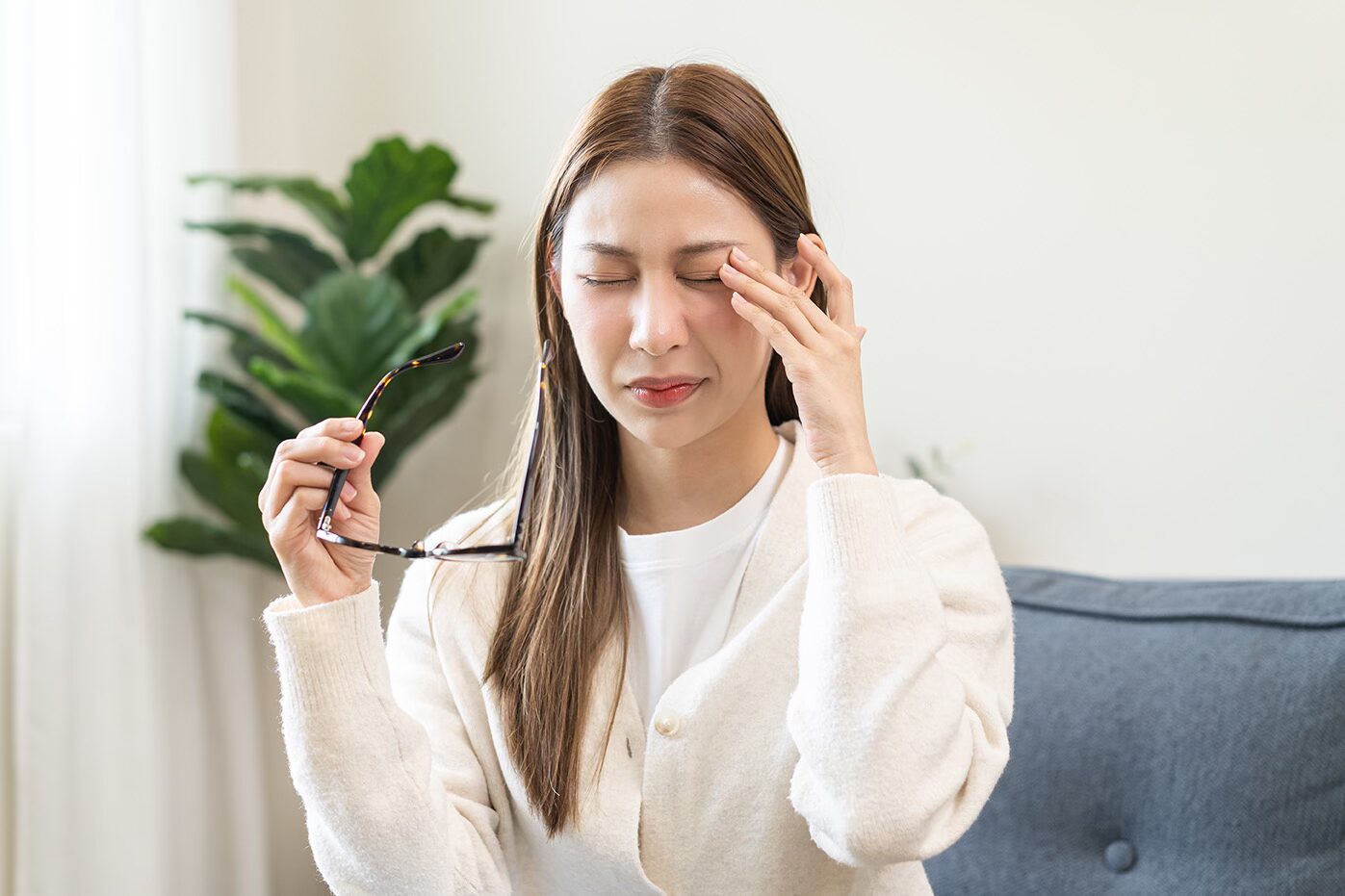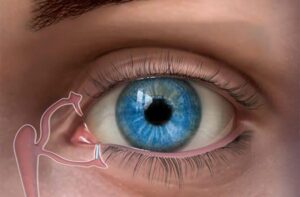Dry eye syndrome is a common condition that can cause discomfort and disrupt your daily life. Whether it’s a persistent feeling of dryness, irritation, or blurred vision, the symptoms can vary, making it challenging to know if you’re experiencing this condition. At Modern Vision Solutions, we’re here to help you understand your symptoms and find effective relief. Schedule a consultation with us today to take the first step toward healthier, more comfortable eyes.
10 Common Signs and Symptoms of Dry Eye Syndrome
10 Common Signs and Symptoms of Dry Eye Syndrome
Dry eye syndrome occurs when your eyes don’t produce enough tears or when tears evaporate too quickly. Recognizing the symptoms can help you address the condition early and prevent further complications. Below are ten common signs and symptoms:
- Burning or Stinging Sensation
A burning or stinging sensation is one of the most noticeable symptoms of dry eye syndrome. This discomfort can feel like your eyes are irritated by smoke or chemicals, even when nothing is present. Environmental factors, such as air conditioning, heating, or exposure to wind, can intensify this symptom. Over time, this persistent irritation can lead to reduced quality of life, especially if it interferes with your ability to concentrate on tasks. - Scratchy or Gritty Feeling
Many people describe dry eyes as feeling like there is sand or debris in them, even when the surface is clear. This scratchy or gritty sensation occurs because of an uneven tear film, which normally helps smooth the surface of the eyes. This symptom can be particularly bothersome during activities in which you are blinking less frequently, such as reading or while staring at a screen. - Redness
Bloodshot or red eyes are a visible indicator of inflammation caused by dry eye syndrome. When your eyes are not adequately lubricated, the blood vessels on the surface can swell, leading to a red or irritated appearance. This symptom can make you look tired or unwell, even if you feel fine otherwise. - Blurred Vision
Blurry or fluctuating vision often accompanies dry eye syndrome, making it difficult to focus on tasks like reading, driving, or using electronic devices. The lack of adequate tears to maintain a stable surface on the eye can lead to inconsistent vision, which might improve temporarily after blinking. - Light Sensitivity
Increased sensitivity to light, also called photophobia, is a common complaint among those with dry eyes. Exposure to bright sunlight, artificial lights, or computer screens may cause discomfort or squinting. This sensitivity can also make everyday activities more challenging, particularly in brightly lit environments. - Watery Eyes
While it might seem contradictory, watery eyes can indicate dry eye syndrome. When your eyes are too dry, they may overproduce tears in an attempt to compensate. However, these tears are often of poor quality and don’t adequately lubricate the eyes, leading to a cycle of irritation and excessive tearing. - Stringy Mucus
The presence of stringy or sticky mucus in or around the eyes is a less common but notable symptom. This occurs when the glands responsible for producing tears or mucus are not functioning properly, leading to an imbalance in tear composition. This can result in discomfort and a need to clear your eyes frequently. - Difficulty Wearing Contact Lenses
Dry eyes can make wearing contact lenses uncomfortable or even impossible for some individuals. Tears provide a natural cushion between the lenses and the surface of your eyes, and insufficient lubrication can lead to irritation, redness, and an increased risk of infection. Many patients report feeling as though their lenses are “sticking” to their eyes or moving improperly. - Eye Fatigue
Eye fatigue, characterized by tired or heavy eyes, often becomes more pronounced as the day progresses. This symptom is particularly noticeable after prolonged activities requiring intense focus, such as working on a computer or reading. Without enough tears to keep your eyes refreshed, they can feel strained and overworked. - Decreased Tear Production
A reduction in tear production is a fundamental sign of dry eye syndrome. Tears are essential for keeping the surface of your eyes hydrated, nourished, and protected. When tear production decreases, you may notice your eyes feeling consistently dry, even in optimal environments. This symptom can be assessed through specific diagnostic tests during an eye exam.
If you are experiencing any of these symptoms, Modern Vision Solutions is here to help. Our specialized team can diagnose the root cause of your dry eye symptoms and provide personalized treatment options. Schedule a consultation today and take the first step toward healthier, more comfortable eyes.

How is dry eye syndrome diagnosed?
in the fields of optometry and ophthalmology, dry eye syndrome is diagnosed through a combination of clinical evaluation and diagnostic tests. At Modern Vision Solutions, the process typically begins with a comprehensive eye examination to assess your symptoms and identify potential contributing factors. This includes reviewing your medical history, examining the structure of your eyelids and blink patterns, and closely inspecting the surface of your eyes.
Diagnostic tests are used to measure tear production, tear quality, and the overall health of the eye’s surface. These tests may include:
- Tear Break-Up Time (TBUT) test – evaluates how quickly your tears evaporate
- Sodium Flourescein or Lissamine Dye Testing – allows us to detect surface dryness and evaluate if your eyelids close correctly
- Advanced diagnostic tools
- Epithelial mapping – checking for irregularities on the surface of the eye
- Corneal topography – maps out the front surface of the eye and checks for higher order abberations that may be caused by dryness
- Tear film analysis – advanced measurements of the quality and quantity of tears on the surface of the eye
- Meibography – advanced imaging of the meibomian glands, which produce the oil layer of the tears
- Slit Lamp Examination – the doctor will do a personalized examination of the eyelids, conjunctiva (lining of the eye and eyelids), tear film, meibomian glands, and more to determine what the best recommendations are for you
Because no single test provides a definitive diagnosis, a combination of these methods allows our team to identify the underlying cause of your dry eye symptoms and determine the best course of treatment. Modern Vision Solutions is equipped with the latest technologies to ensure an accurate diagnosis and personalized care for each patient.
How is dry eye syndrome treated at Modern Vision Solutions?
Modern Vision Solutions treats dry eye syndrome using advanced solutions like BlephEx®, LipiFlow®, and OptiLIGHT, as well as punctal plugs. These innovative treatments target the underlying causes of dry eye to provide long-lasting relief and improve overall eye health. Schedule your consultation with our dry eye experts to learn more about how these treatments can help you achieve better comfort and vision.
FAQ’s About How You Know If You Have Dry Eye Syndrome
What are the early warning signs of dry eye syndrome?
The early signs of dry eye syndrome include mild irritation, a gritty feeling, or temporary blurry vision. These symptoms can interfere with your visual perception, making everyday activities like reading or driving more challenging. Modern Vision Solutions offers personalized evaluations and treatments, including artificial tears and advanced therapies, to address these early warning signs effectively.
Can seasonal changes make dry eye symptoms worse?
Seasonal changes, particularly during dry or windy weather, can reduce the moisture in the air and worsen dry eye symptoms. For individuals prone to allergies, these changes can intensify irritation. Modern Vision Solutions provides tailored treatments, such as recommending a humidifier or advanced therapies, to manage seasonal triggers and improve eye comfort.
Is digital screen use a common cause of dry eye syndrome?
Prolonged screen time reduces your blink rate, which can lead to dry eye syndrome by disrupting tear distribution and reducing moisture. Modern Vision Solutions can help you address digital eye strain with treatments like artificial tears or punctal plugs, combined with strategies to improve your overall eye health.
How does age affect the likelihood of developing dry eye syndrome?
As you age, the quality of your tear production often decreases, increasing the risk of dry eye syndrome. Hormonal changes, particularly in post-menopausal women, can also contribute. Modern Vision Solutions evaluates age-related factors and provides solutions like eye drops, medications, or advanced treatments to restore comfort and protect your vision.
Can wearing contact lenses cause dry eye syndrome?
Contact lenses can lead to dry eye syndrome by disrupting the natural tear ducts and reducing eye moisture. If you experience discomfort while wearing contacts, Modern Vision Solutions offers alternative solutions such as glasses or advanced therapies to improve tear stability and reduce irritation.
Are dry eye symptoms the same for everyone?
Dry eye symptoms vary widely, from mild dryness to severe irritation or blurry vision. Some individuals may experience complications like blepharitis or inflammation of the eyelids. Modern Vision Solutions provides individualized care, identifying your specific symptoms and offering targeted treatments like punctal plugs or lid hygiene therapies.
Does dry eye syndrome cause permanent damage to the eyes?
Untreated dry eye syndrome can lead to chronic inflammation, damage to the cornea, or complications like blepharitis. Modern Vision Solutions emphasizes early treatment with therapies such as artificial tears, punctal plugs, or advanced procedures to prevent permanent damage and maintain optimal vision.
How can I differentiate between dry eye syndrome and allergies?
While both allergies and dry eye syndrome can cause redness and irritation, allergies often involve itchiness and are seasonal. Dry eye syndrome, however, is more likely to affect your visual perception and tear quality. Modern Vision Solutions uses diagnostic tools to distinguish between the two and recommend appropriate treatments like eye drops or allergy relief.
What are the risks of ignoring dry eye symptoms?
Ignoring dry eye symptoms can lead to worsening discomfort, chronic inflammation, and complications that impact your everyday life, such as difficulty focusing or driving. Modern Vision Solutions encourages proactive care with personalized treatments like punctal plugs or medications to protect your long-term eye health.
Can dry eye syndrome affect my vision long-term?
Chronic dry eye syndrome can impair visual perception and lead to corneal damage if untreated. Modern Vision Solutions offers effective treatments, including artificial tears, medications, and advanced therapies, to improve tear film stability and protect your vision for the future.











